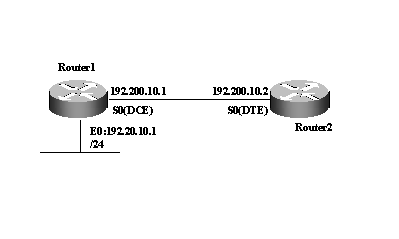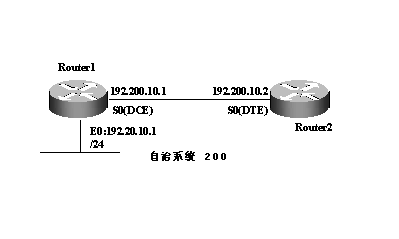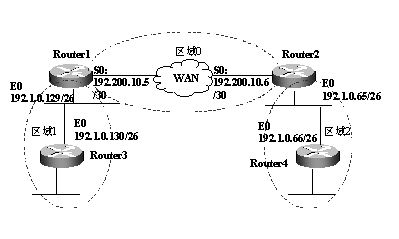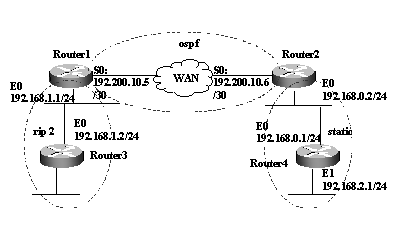路由協議設置詳細圖解
路由協議設置詳細圖解
一、RIP協議
RIP(Routing information Protocol)是應用較早、使用較普遍的內部網關協議(Interior Gateway Protocol,簡稱IGP),適用于小型同類網絡,是典型的距離向量(distance-vector)協議。文檔見RFC1058、RFC1723。
? RIP通過廣播UDP報文來交換路由信息,每30秒發送一次路由信息更新。RIP提供跳躍計數(hop count)作為尺度來衡量路由距離,跳躍計數是一個包到達目標所必須經過的路由器的數目。如果到相同目標有二個不等速或不同帶寬的路由器,但跳躍計數相同,則RIP認為兩個路由是等距離的。RIP最多支持的跳數為15,即在源和目的網間所要經過的最多路由器的數目為15,跳數16表示不可達。
1. ?????? 有關命令
|
任務 |
命令 |
|
指定使用RIP協議 |
router rip |
|
指定RIP版本 |
version {1|2}1 |
|
指定與該路由器相連的網絡 |
network network |
注:1.Cisco的RIP版本2支持驗證、密鑰管理、路由匯總、無類域間路由(CIDR)和變長子網掩碼(VLSMs)
2. ?????? 舉例

Router1:
router rip
version 2
network 192.200.10.0
network 192.20.10.0
!
相關調試命令:
show ip protocol
show ip route
二、IGRP協議
IGRP (Interior Gateway Routing Protocol)是一種動態距離向量路由協議,它由Cisco公司八十年代中期設計。使用組合用戶配置尺度,包括延遲、帶寬、可靠性和負載。
缺省情況下,IGRP每90秒發送一次路由更新廣播,在3個更新周期內(即270秒),沒有從路由中的第一個路由器接收到更新,則宣布路由不可訪問。在7個更新周期即630秒后,Cisco IOS 軟件從路由表中清除路由。 ?
1. ?????? 有關命令?
|
任務 |
命令 |
|
指定使用RIP協議 |
router igrp autonomous-system1 |
|
指定與該路由器相連的網絡 |
network network |
|
指定與該路由器相鄰的節點地址 |
neighbor ip-address |
注:1、autonomous-system可以隨意建立,并非實際意義上的autonomous-system,但運行IGRP的路由器要想交換路由更新信息其autonomous-system需相同。
2.舉例

Router1:
router igrp 200
network 192.200.10.0
network 192.20.10.0
!
三、OSPF協議
OSPF(Open Shortest Path First)是一個內部網關協議(Interior Gateway Protocol,簡稱IGP),用于在單一自治系統(autonomous system,AS)內決策路由。與RIP相對,OSPF是鏈路狀態路有協議,而RIP是距離向量路由協議。
鏈路是路由器接口的另一種說法,因此OSPF也稱為接口狀態路由協議。OSPF通過路由器之間通告網絡接口的狀態來建立鏈路狀態數據庫,生成最短路徑樹,每個OSPF路由器使用這些最短路徑構造路由表。
文檔見RFC2178。 ?
1.有關命令?
全局設置
|
任務 |
命令 |
|
指定使用OSPF協議 |
router ospf process-id1 |
|
指定與該路由器相連的網絡 |
network address wildcard-mask area area-id2 |
|
指定與該路由器相鄰的節點地址 |
neighbor ip-address |
? 注:1、OSPF路由進程process-id必須指定范圍在1-65535,多個OSPF進程可以在同一個路由器上配置,但最好不這樣做。多個OSPF進程需要多個OSPF數據庫的副本,必須運行多個最短路徑算法的副本。process-id只在路由器內部起作用,不同路由器的process-id可以不同。
???????? 2、wildcard-mask 是子網掩碼的反碼, 網絡區域ID area-id在0-4294967295內的十進制數,也可以是帶有IP地址格式的x.x.x.x。當網絡區域ID為0或0.0.0.0時為主干域。不同網絡區域的路由器通過主干域學習路由信息。
2.基本配置舉例:

? Router1:
interface ethernet 0
?ip address 192.1.0.129 255.255.255.192
!
interface serial 0
?ip address 192.200.10.5 255.255.255.252
!
router ospf 100
?network 192.200.10.4 0.0.0.3 area 0
?network 192.1.0.128 0.0.0.63 area 1
!
Router2:
interface ethernet 0
?ip address 192.1.0.65 255.255.255.192
!
interface serial 0
?ip address 192.200.10.6 255.255.255.252
!
router ospf 200
?network 192.200.10.4 0.0.0.3 area 0
?network 192.1.0.64 0.0.0.63 area 2
!
Router3:
interface ethernet 0
?ip address 192.1.0.130 255.255.255.192
!
router ospf 300
?network 192.1.0.128 0.0.0.63 area 1
!
Router4:
interface ethernet 0
?ip address 192.1.0.66 255.255.255.192
!
router ospf 400
?network 192.1.0.64 0.0.0.63 area 1
!
相關調試命令:
debug ip ospf events
debug ip ospf packet
show ip ospf
show ip ospf database
show ip ospf interface
show ip ospf neighbor
show ip route??
3. 使用身份驗證
為了安全的原因,我們可以在相同OSPF區域的路由器上啟用身份驗證的功能,只有經過身份驗證的同一區域的路由器才能互相通告路由信息。
在默認情況下OSPF不使用區域驗證。通過兩種方法可啟用身份驗證功能,純文本身份驗證和消息摘要(md5)身份驗證。純文本身份驗證傳送的身份驗證口令為純文本,它會被網絡探測器確定,所以不安全,不建議使用。而消息摘要(md5)身份驗證在傳輸身份驗證口令前,要對口令進行加密,所以一般建議使用此種方法進行身份驗證。
使用身份驗證時,區域內所有的路由器接口必須使用相同的身份驗證方法。為起用身份驗證,必須在路由器接口配置模式下,為區域的每個路由器接口配置口令。 ?
|
任務 |
命令 |
|
指定身份驗證 |
area area-id authentication [message-digest] |
|
使用純文本身份驗證 |
ip ospf authentication-key password |
|
使用消息摘要(md5)身份驗證 |
ip ospf message-digest-key keyid md5 key |
???? 以下列舉兩種驗證設置的示例,示例的網絡分布及地址分配環境與以上基本配置舉例相同,只是在Router1和Router2的區域0上使用了身份驗證的功能。:
? 例1.使用純文本身份驗證?
Router1:
interface ethernet 0
?ip address 192.1.0.129 255.255.255.192
!
interface serial 0
?ip address 192.200.10.5 255.255.255.252
?ip ospf authentication-key cisco
!
router ospf 100
?network 192.200.10.4 0.0.0.3 area 0
?network 192.1.0.128 0.0.0.63 area 1
?area 0 authentication
!
Router2:
interface ethernet 0
?ip address 192.1.0.65 255.255.255.192
!
interface serial 0
?ip address 192.200.10.6 255.255.255.252
?ip ospf authentication-key cisco??
!
router ospf 200
?network 192.200.10.4 0.0.0.3 area 0
?network 192.1.0.64 0.0.0.63 area 2
?area 0 authentication
!??
例2.消息摘要(md5)身份驗證: ?
Router1:
interface ethernet 0
?ip address 192.1.0.129 255.255.255.192
!
interface serial 0
?ip address 192.200.10.5 255.255.255.252
?ip ospf message-digest-key 1 md5 cisco
!
router ospf 100
?network 192.200.10.4 0.0.0.3 area 0
?network 192.1.0.128 0.0.0.63 area 1
?area 0 authentication message-digest
!
Router2:
interface ethernet 0
?ip address 192.1.0.65 255.255.255.192
!
interface serial 0
?ip address 192.200.10.6 255.255.255.252
?ip ospf message-digest-key 1 md5 cisco
!
router ospf 200
?network 192.200.10.4 0.0.0.3 area 0
?network 192.1.0.64 0.0.0.63 area 2
?area 0 authentication message-digest
!
相關調試命令:
debug ip ospf adj
debug ip ospf events
四、重新分配路由
在實際工作中,我們會遇到使用多個IP路由協議的網絡。為了使整個網絡正常地工作,必須在多個路由協議之間進行成功的路由再分配。
? 以下列舉了OSPF與RIP之間重新分配路由的設置范例:

? Router1的Serial 0端口和Router2的Serial 0端口運行OSPF,在Router1的Ethernet 0端口運行RIP 2,Router3運行RIP2,Router2有指向Router4的192.168.2.0/24網的靜態路由,Router4使用默認靜態路由。需要在Router1和Router3之間重新分配OSPF和RIP路由,在Router2上重新分配靜態路由和直連的路由。 ?
范例所涉及的命令
|
任務 |
命令 |
|
重新分配直連的路由 |
redistribute connected |
|
重新分配靜態路由 |
redistribute static |
|
重新分配ospf路由 |
redistribute ospf process-id metric metric-value |
|
重新分配rip路由 |
redistribute rip metric metric-value |
? Router1:
interface ethernet 0
?ip address 192.168.1.1 255.255.255.0
!
interface serial 0
?ip address 192.200.10.5 255.255.255.252
!
router ospf 100
?redistribute rip metric 10
?network 192.200.10.4 0.0.0.3 area 0
!
router rip
?version 2
?redistribute ospf 100 metric 1
?network 192.168.1.0
!
Router2:
interface loopback 1
?ip address 192.168.3.2 255.255.255.0
!
interface ethernet 0
?ip address 192.168.0.2 255.255.255.0
!
interface serial 0
?ip address 192.200.10.6 255.255.255.252
!
router ospf 200
?redistribute connected subnet
?redistribute static subnet
?network 192.200.10.4 0.0.0.3 area 0
!
ip route 192.168.2.0 255.255.255.0 192.168.0.1
!
Router3:
interface ethernet 0
?ip address 192.168.1.2 255.255.255.0
!
router rip
?version 2
?network 192.168.1.0
!
? Router4:
interface ethernet 0
?ip address 192.168.0.1 255.255.255.0
!
interface ethernet 1
?ip address 192.168.2.1 255.255.255.0
!
ip route 0.0.0.0 0.0.0.0 192.168.0.2
!
五、IPX協議設置
IPX協議與IP協議是兩種不同的網絡層協議,它們的路由協議也不一樣,IPX的路由協議不象IP的路由協議那樣豐富,所以設置起來比較簡單。但IPX協議在以太網上運行時必須指定封裝形式。?
1. 有關命令?
|
啟動IPX路由 |
ipx routing |
|
設置IPX網絡及以太網封裝形式 |
ipx network network [encapsulation encapsulation-type]1 |
|
指定路由協議,默認為RIP |
ipx router {eigrp autonomous-system-number | nlsp [tag] | rip} |
?注:1.network 范圍是1 到FFFFFFFD.
IPX封裝類型列表
|
接口類型 |
封裝類型 |
IPX幀類型 |
|
Ethernet |
novell-ether (默認) arpa sap snap? |
Ethernet_802.3 Ethernet_II Ethernet_802.2 Ethernet_Snap |
|
Token Ring |
sap (默認) snap |
Token-Ring Token-Ring_Snap |
|
FDDI |
snap (默認) sap novell-fddi |
Fddi_Snap Fddi_802.2 Fddi_Raw |
舉例:
在此例中,WAN的IPX網絡為3a00,Router1所連接的局域網IPX網絡號為2a00,在此局域網有一臺Novell服務器,IPX網絡號也是2a00, 路由器接口的IPX網絡號必須與在同一網絡的Novell服務器上設置的IPX網絡號相同。路由器通過監聽SAP來建立已知的服務及自己的網絡地址表,并每60秒發送一次自己的SAP表。

Router1:
ipx routing
interface ethernet 0
?ipx network 2a00 encapsulation sap
!
interface serial 0
?ipx network 3a00
!
ipx router eigrp 10
?network 3a00
?network 2a00
!
Router2:
ipx routing
interface ethernet 0
?ipx network 2b00 encapsulation sap
!
interface serial 0
?ipx network 3a00
!
ipx router eigrp 10
?network 2b00
?network 3a00
! ?
相關調試命令:
debug ipx packet
debug ipx routing
debug ipx sap
debug ipx spoof
debug ipx spx
show ipx eigrp interfaces
show ipx eigrp neighbors
show ipx eigrp topology
show ipx interface
show ipx route
show ipx servers
show ipx spx-spoof
非常好我支持^.^
(2) 100%
不好我反對
(0) 0%
相關閱讀:
- [電子說] OSPF鏈路狀態路由協議學習筆記 2023-08-23
- [通信網絡] OSPF是如何計算路由的?OSPF如何適應大型網絡的? 2023-08-18
- [電子說] 動態路由協議的基本工作原理 BGP Path Attributes與路由選擇 2023-07-31
- [電子說] 萬字爆肝整理-詳解路由協議 2023-07-26
- [通信網絡] 什么是is-is路由協議 IS-IS路由協議配置實踐 2023-07-25
- [通信網絡] 路由協議都有哪些 計算機網絡核心技術主要包括哪些 2023-07-24
- [電子說] 路由協議&OSPF中雙點雙向重發布解決路由引入問題(華為) 2023-06-25
- [電子說] OSPF路由協議:?趣解OSPF區域 2023-05-24
( 發表人:admin )
